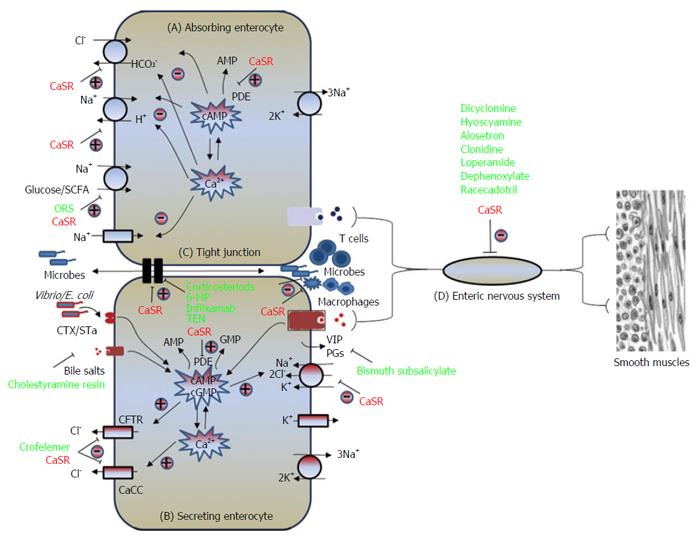Copyright
©The Author(s) 2016.
World J Gastroenterol. Mar 7, 2016; 22(9): 2711-2724
Published online Mar 7, 2016. doi: 10.3748/wjg.v22.i9.2711
Published online Mar 7, 2016. doi: 10.3748/wjg.v22.i9.2711
Figure 1 Illustrates the four common pathways leading to formation of diarrhea.
The four pathways are: A: Impaired absorption (cause of osmotic diarrhea); B: Excessive secretion (leading to secretory diarrhea); C: Breakdown of intestinal barrier and enhanced inflammation (implicated in inflammatory diarrhea); D: Overly active enteric nervous system (presumed cause of neurogenic diarrhea seen in irritable bowel syndrome). Note that while most current antidiarrheal therapeutics (green-colored) target one individual pathway, CaSR activators (red-colored) have the potential of correcting changes in all the four diarrhea-causing pathways. CaCC: Calcium-activated chloride channel; CaSR: Calcium-sensing receptor; CFTR: Cystic fibrosis transmembrane conductance regulator; CTX: Cholera toxin; ORS: Oral rehydration solution; PDE: Phosphodiesterase; PG: Prostaglandin; SCFA: Short-chain fatty acid; STa: Heat stable toxin; VIP: Vasoactive intestinal peptide.
- Citation: Cheng SX. Calcium-sensing receptor: A new target for therapy of diarrhea. World J Gastroenterol 2016; 22(9): 2711-2724
- URL: https://www.wjgnet.com/1007-9327/full/v22/i9/2711.htm
- DOI: https://dx.doi.org/10.3748/wjg.v22.i9.2711









